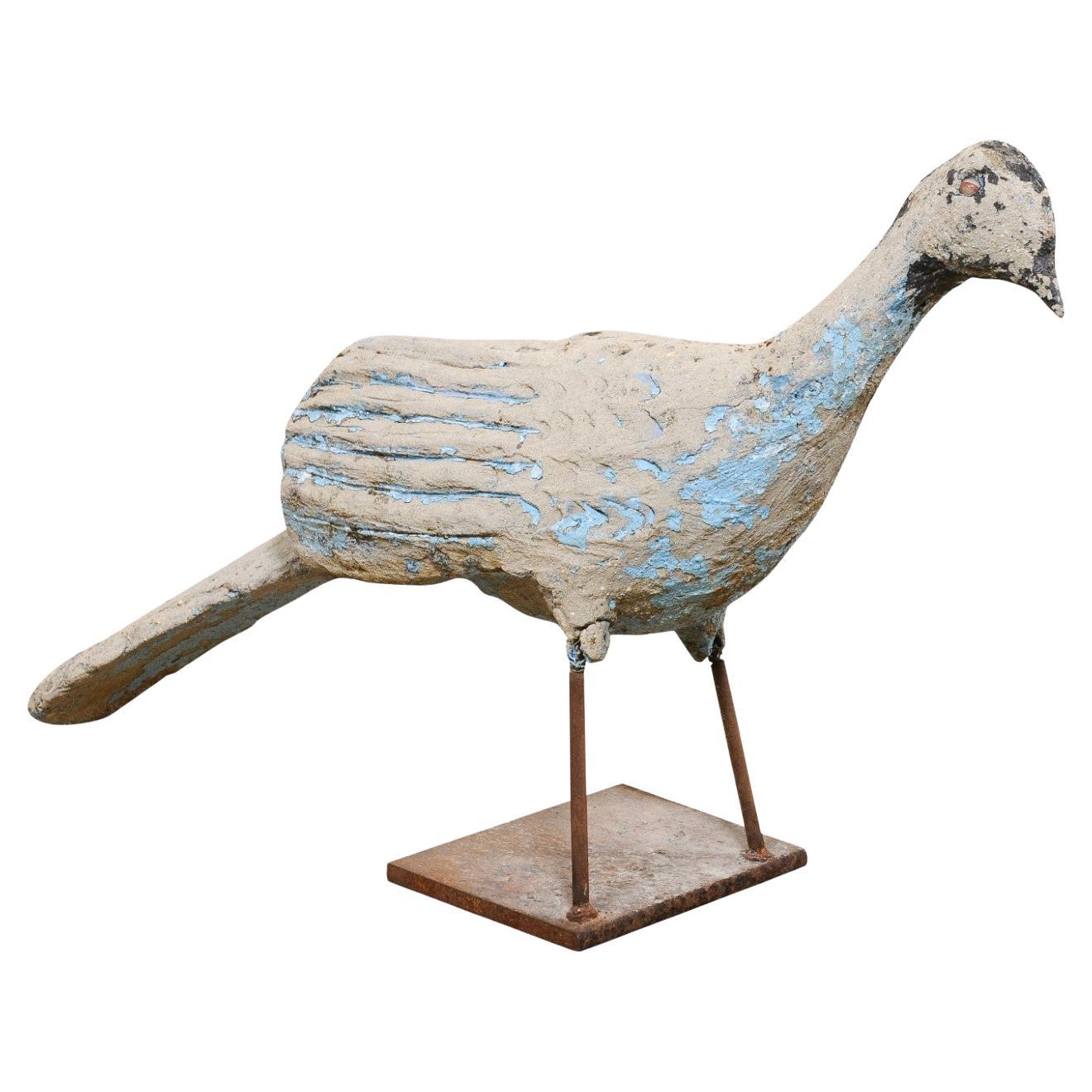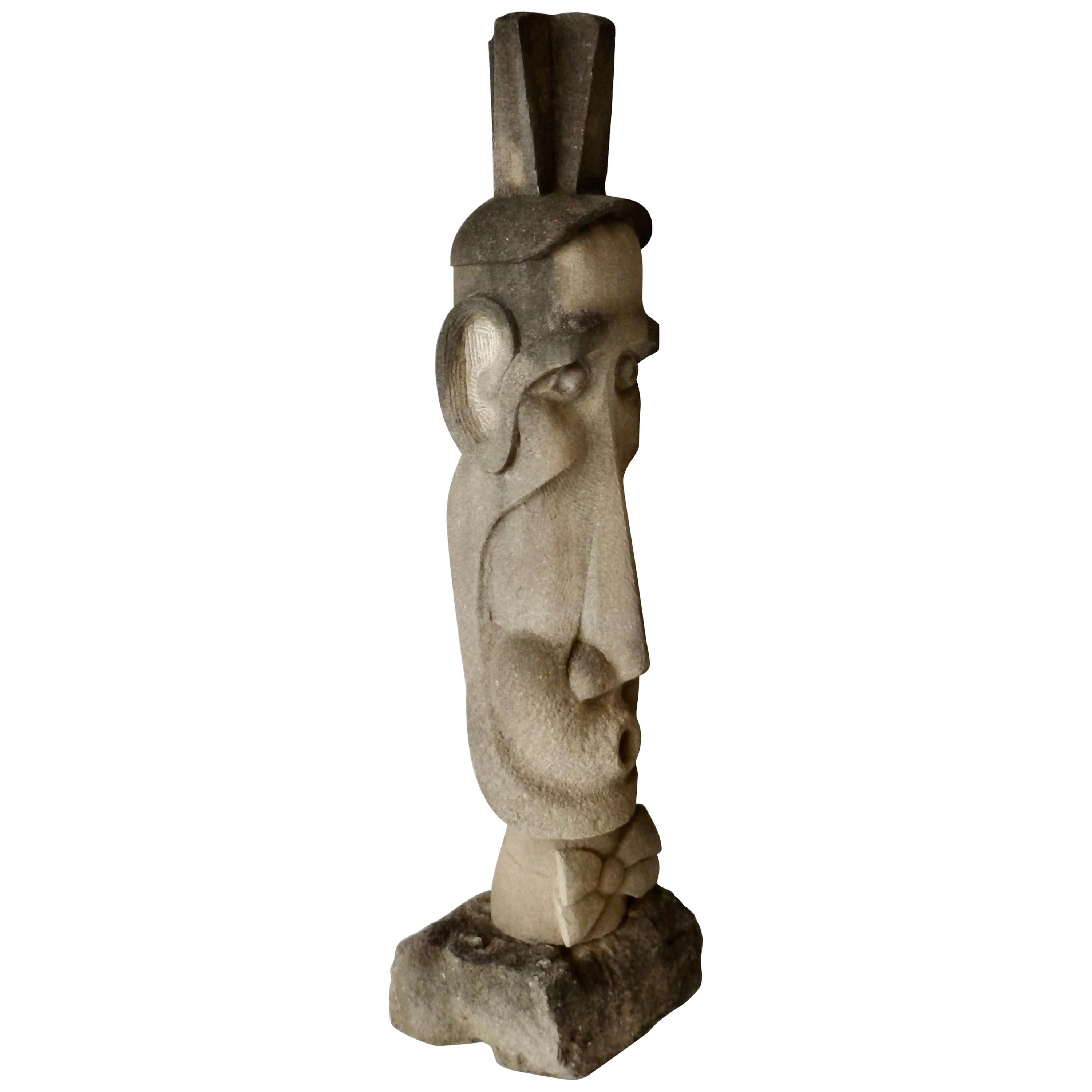Items Similar to Fox Sculpture Wirework Garden `Ornament
Want more images or videos?
Request additional images or videos from the seller
1 of 12
Fox Sculpture Wirework Garden `Ornament
About the Item
A folk art, life-size, fox, wirework, garden sculpture
Hand-sculpted using multiple layers of painted galvanized wire in red, white and black. Each sculpture is unique. This fox is very realistic and often mistaken for the real thing, creating humour in the landscape.
“These beautiful, life-size, wire-work animals bring charm and character to any garden ..”
This fox can be customised and ordered individually
length 91cm., 3ft height 28cm., 11" depth 15cm., 6"
WIREWORK SCULPTURE
Wirework is an ancient art form, probably first practised by the Egyptians around 3000BC. Early examples have been discovered in the burial chambers of important people throughout the ancient world. In 2600BC, wire was used in gold and silver ribbons for entwining in the hair of courtly ladies in the Sumerian city of Ur. The art of wirework spread in various forms from Babylon to Baghdad, Damascus and Constantinople before finally reaching Europe.
Wire was originally made by chiselling thin strips from a sheet of metal. The strips were either twisted and then rolled between two flat surfaces to smooth them or spirally wound around a mandrel. Today wire is made by drawing rods of metal through conically shaped holes in a draw-plate. This system was first used in Persia in the 6th century BC but did not reach Europe until the 10th century AD when wire was first being produced on a commercial scale.
The iron wire trade made chain-mail, and also wool carders, girdles, chains, fish hooks and needles. Up until this time gold and silver wires were made almost exclusively for jewellery but during the Middle Ages embroidery became their principal use. In England, the two trades were governed by different bodies, the Broiders’ Company and the Girdler and Pinmakers’ Company. It was not until the late 17th century that they became distinctive guilds known as the Worshipful Company of Gold and Silver Wireworkers, and the Worshipful Company of Tin Plate Workers, or Wireworkers.
By the mid-16th century, there were at least 6,000 wire drawers in London alone and it was around this time that the first mechanical drawing machines were used in England. The water-driven draw-plate system used in these machines was invented by Rudolf of Nuremberg in the 14th century, but was not introduced to England until 1564. Gold and silver wirework flourished until the time of the French Revolution (1789-99), when fashions changed and the industry went into decline.
Because of the corrodible nature of iron, very few examples of the broad range of objects once made from iron wire have survived to this day, save the items mentioned above and a few toys and traps. By the early 19th century, tinning and black-japanning had become popular ways of protecting the wireworker’s craft. Not only did these treatments prevent rusting, they also helped cement items made from unsoldered wire.
America imported its wire from England and Germany until 1812, when the war with England meant that supplies were cut off. From this point, the Americans started building their own factories for producing wire. By the mid-19th century, the steam engine enabled wire, woven wire and wire fencing to be mass produced. The industry flourished, reaching its peak in Europe and America at the turn of the century, when an impressive range of products was available, from wire whisks and baskets to wire gazebos. The craft of wireworking was applied to every possible household device until the advent of plastic gradually led to its demise.
Alexander Calder (1898-1976) was the first artist who brought wire sculpture art to people's attention was Alexander Calder (, who made a series of wire sculptures in the 1920s after using wire to experiment with jewelry making. The artistic practice of wirework is now enjoying a renaissance in the fine and decorative arts.
- Dimensions:Height: 11.03 in (28 cm)Width: 35.83 in (91 cm)Depth: 5.91 in (15 cm)
- Materials and Techniques:
- Place of Origin:
- Period:
- Date of Manufacture:2020
- Production Type:New & Custom(One of a Kind)
- Estimated Production Time:12-13 weeks
- Condition:
- Seller Location:BUNGAY, GB
- Reference Number:1stDibs: LU3867332094152
different pose and colouring
About the Seller
5.0
Vetted Seller
These experienced sellers undergo a comprehensive evaluation by our team of in-house experts.
Established in 1985
1stDibs seller since 2018
84 sales on 1stDibs
Typical response time: 12 hours
- ShippingRetrieving quote...Ships From: BUNGAY, United Kingdom
- Return PolicyA return for this item may be initiated within 7 days of delivery.
More From This SellerView All
- Sculpture Stone Mother & Child Biomorphic Mid-Century ModernLocated in BUNGAY, SUFFOLKA large, 28“ high, modernist, biomorphic, Mother & Child, stone sculpture, mid-20th century. Artist unknown. Private Collection. This marble sculpture is equally striking displaye...Category
20th Century English Mid-Century Modern Figurative Sculptures
MaterialsStone
- Sculpture, statue, garden, wirework, sheep, life-size, folk art, animal, uniqueLocated in BUNGAY, SUFFOLKA Pair of Contemporary, Folk Art, Life-Size, Sheep, Wirework, Garden Sculptures Hand-sculpted using multiple layers of painted galvanized wire in white and black. Each sculpture is...Category
2010s English Folk Art Animal Sculptures
MaterialsWire
- Lion Stone Sculpture Architectural Garden RenaissanceLocated in BUNGAY, SUFFOLKThis sculpture has taken on a different character over time as it has weathered and the detailing has softened. Time has given it a pared down, minimalist quality juxtaposing the R...Category
Antique 16th Century English Renaissance Statues
MaterialsLimestone
- Daschund Ceramic Blue & White Vintage Life Size Sculpture GardenLocated in BUNGAY, SUFFOLKLife-sized, standard Daschund, ceramic sculpture suitable for the home or garden The blue and white stylised flowerhead and trailing acanthus leaf decoration is unusual and fun, evo...Category
Vintage 1950s English Mid-Century Modern Animal Sculptures
MaterialsPorcelain
- Watering Can Hot Water Jug Brass Large 49cm., 19" longLocated in BUNGAY, SUFFOLKBeautiful collectors item or decorative object. Suitable for regular use injecting a touch of history into gardening A fine Victorian oval, brass watering can or hot water jug...Category
Antique 19th Century English Victorian Planters and Jardinieres
MaterialsBrass
- fishing float buoy green black clear glass sea nauticalLocated in BUNGAY, SUFFOLKRARE, LARGE COLLECTION OF GREEN, BLACK & CLEAR GLASS & FISHING FLOATS OR BUOYS WITH THE MAKERS MARKS FOR SMALL NETS c.1910 Displaying a variety of makers marks and symbols such as a...Category
Vintage 1910s English Art Deco Nautical Objects
MaterialsBlown Glass
You May Also Like
- Frog Garden Ornament or Desk WeightLocated in Los Angeles, CASmall Frog Garden Ornament or Desk Weight.Category
20th Century American Adirondack Animal Sculptures
MaterialsIron
- Spanish Peacock 2 Ft. Tall Patio Garden Lawn Ornament, Mid-CenturyLocated in Atlanta, GAA Spanish painted peacock garden statue from the mid 20th century. This vintage statue from Spain, created of cast stone with iron legs, features a lovely little peafowl bird -standi...Category
Mid-20th Century Spanish Animal Sculptures
MaterialsCast Stone, Iron
- French Classical Cast Hard Stone Panier de Fruits Garden Ornament, 20th CLocated in Big Flats, NYA French Classical garden ornament offers cast hard stone statue depicting Panier de Fruits (Basket of Fruit), 20th century Measures- 12''H x 10.5''W x 10.5''D. Catalogue Note: Ask...Category
20th Century European Classical Greek Garden Ornaments
MaterialsStone
- Hand Carved Marble Lioness Garden SculptureLocated in Douglas Manor, NYHand carved marble abstract lioness sculpture signed L.Meyer.Category
Vintage 1960s Garden Ornaments
MaterialsMarble
- English Bulldog Iron Garden Sculpture/DoorstopLocated in Douglas Manor, NYEnglish hand cast English bulldog rusted garden ornament.Category
Vintage 1930s Animal Sculptures
MaterialsIron
- Whimsical Carved Stone Garden Lawn SculptureLocated in Ferndale, MIInteresting fun whimsical carved stone garden sculpture. Base measures: 12 x 9 at 6" tall.Category
Mid-20th Century American Mid-Century Modern Figurative Sculptures
MaterialsStone





